Welcome Steemians! This is part 6 of our documentation of the vermifiltration toilet in East Lombok
We are creating an off grid flush toilet that is also a composting toilet using locally available materials and skills.
This project is intended to build and test this system of building toilet/washrooms using reusable formwork for ferrocement water tanks, vermifiltration and integrated wastewater gardens
If you're new please check out our previous installments @
https://steemit.com/permaculture/@reville/evolving-the-tiger-toilet-part-1
https://steemit.com/permaculture/@reville/evolving-the-tiger-toilet-part-2
https://steemit.com/permaculture/@reville/evolving-the-tiger-toilet-part-3
https://steemit.com/permaculture/@reville/evolving-the-tiger-toilet-part-4
https://steemit.com/permaculture/@reville/evolving-the-tiger-toilet-part-5
https://steemit.com/permaculture/@reville/evolving-the-tiger-toilet-part-7
Making the roof
Being a round construction means roofing is a little more complicated than a squared building. We have chosen to use Ijuk, the black fibres from the Sugar palm grown in Lombok. We are making our own thatch on site from the raw materials of local Bamboo and Ijuk, with Ijuk string. The only inorganic materials in the roof are some iron nails. The wood supports will be wood and bamboo
Splitting Asian Bamboo
Asian species of bamboo are very easy to split, unlike American species like Guadua. We split these to various widths to create the strips to attach the thatching bundles
Parman demonstrates how to easily split bamboo with a machete and a crowbar
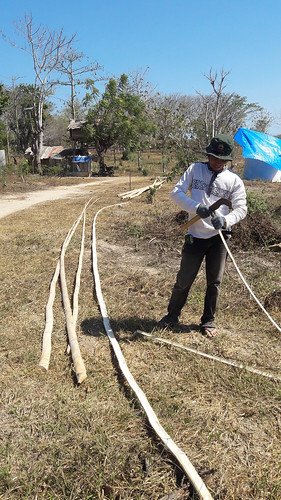
Ijuk thatch from the Sugar palm (Arenga pinnata)
The Sugar palm, is called Enau in Lomboks Sasak language. In Indonesian it is called Aren, while in nearby Bali Jakar
https://en.wikipedia.org/wiki/Arenga_pinnata
The dark fibrous bark (known as doh in India) is manufactured into cordage. In Indonesia the black fibres surrounding the trunk, called ijuk fibres, are used as the organic roof material common in Indonesian vernacular architecture. According to the study on bas-reliefs of Javanese ancient temples such as Borobudur, this type of roof are known in ancient Java vernacular architecture. It can be found today in Balinese temple roof architecture and Minangkabau Rumah Gadang gonjong horn-like curved roof architecture, such as those found in Pagaruyung Palace. The ijuk fibres can also be made into rope, used in brooms, or used as filters to clear the water.
In Bali these fibres are reserved for sacred buildings, either temples or for very traditional homes, however, in Lombok, there are no Taboos against it's general usage and so we want to try and encourage its use.
It is very long lasting and yet sustainably produced by the many palms growing in the foothill agroforests around Mount Rinjani. Its only enemy is fire, as it is flammable like all thatches.
Sugar palm grove. Although in Lombok they tend to be very mixed plantations with Coffee, Durian, Rambutan, Avocado and Cassava interplanted as a multilayer agroforest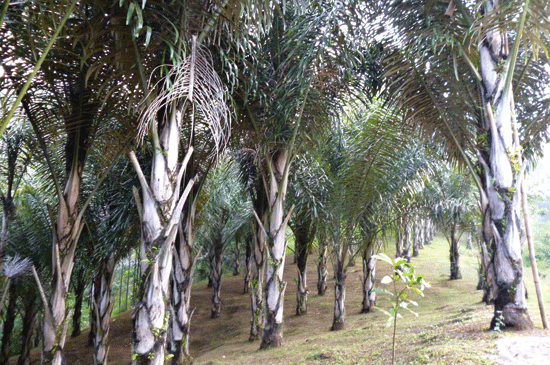
The fruit flesh contains a skin irritant but these are processed and the seeds extracted, these jelly like seeds are edible and used in local desserts
The Palms are tapped for a sugar rich syrup that is reduced to Palm sugar cakes, Gula Aren
The most favourite use in Lombok is to make Tuak, there are two types, sweet and alcoholic, the alcohol containing form is about 3.5% alcohol and widely consumed almost exclusively by men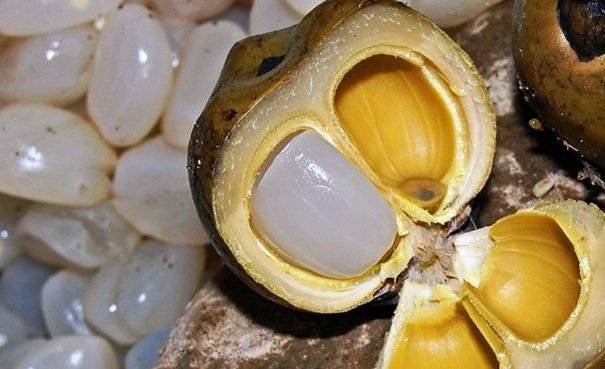
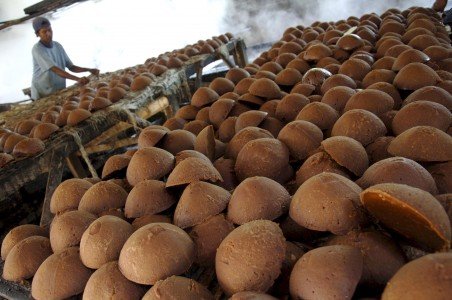

While drinking alcoholic Tuak is mostly by men, Women and children drink the non-alcoholic fresh Tuak manis as a refreshing drink.
The men like to Drink the more potent version and sing songs, like this one about our area, Tanjung Ringgit.
But back to the Ijuk roof!
Pak Agus and Parman begin tying the Ijuk bundles to the bamboo strips
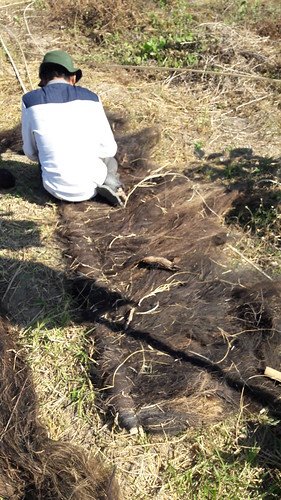
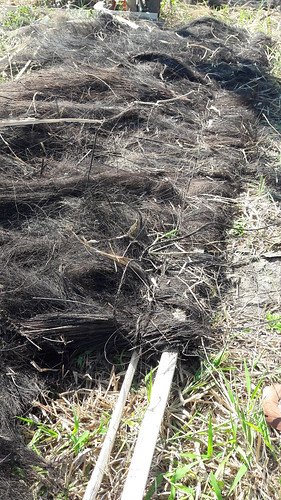
Render with Lime and white cement
The walls of the ferrocement toilet block received a render made of Builder lime with white cement. The light colour reflects heat while the lime component in the render helps the structure breathe as lime is permeable to water vapours. This helps any water trapped inside the structure's walls to escape which is good for the longevity of the structure
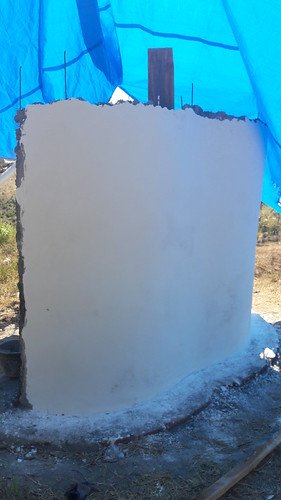
Amaq Agung used his initiative and did this all by himself on his day off. I think this project is quite exciting for the team as it is for me, we are pioneering new designs and techniques for the area, along with incorporating very traditional concepts and materials.
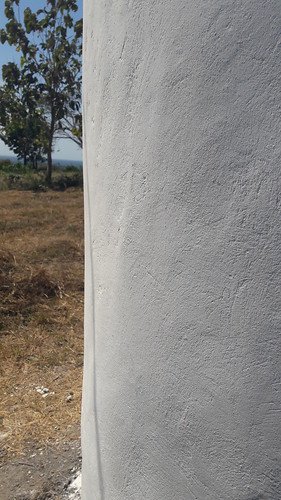
I had intended to use a 1:1:1 of decorative pale sand: Lime: white cement. Amaq Agung used 1:1 Lime: white cement. This does increase the carbon footprint of the structure but only by 1/3 or approximately 30Kg of CO2 equivalent. The result, however, quite good and attractive. With the sand addition it would have been a more cream colour instead of a lime white, however after inspecting im pretty happy that the aesthetics will fit into the landscape once the trees grow and gardens establish around it, we might also lime wash it with some oxide pigment augmented mix to stain it a little less white.
The knowledge transfer occuring in this project is interesting. They learn more English, i learn more Technical Bahasa Indonesia and Sasak terminology. They show me practical building skills using traditional materaials and i show them some tricks from the science of building materials
Locally there is a lot of use of portland cement, but much of it potential is squandered. Poor mixing, too much water, too fast drying time, not using modern additives that can increase strength, reduce cost and enhance longevity. One such gap in knowledge is the need to keep cement damp after it sets to increase its strength. Ideally this is up to 6 months, however 7-28 days is practically ideal. This is even more true for lime based renders as the free calcium hydroxide slowly soaks up carbon dioxide from the atmosphere and returns to Calcium carbonate crystals through carbonation. This takes time, and moisture.
Limestone is burnt to create builder lime, over time this reabsorbs Carbon dioxide from the atmosphere to reform limestone. This gives Lime a lower carbon footprint than portland cement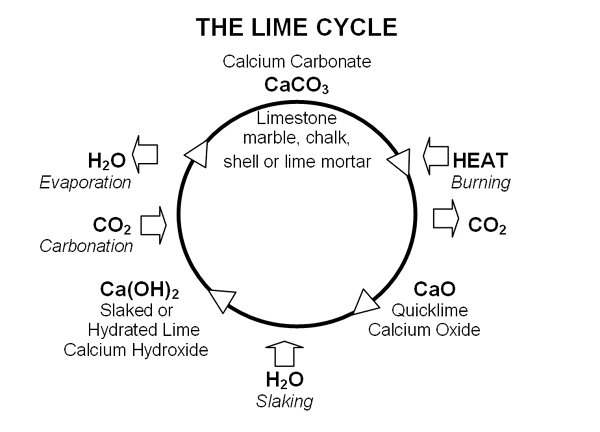
I've explained to Amaq Agung to keep the surfaces damp by watering every day for at least 1 week. This took some convincing! The gap between my practical knowledge and their knowledge of the materials chemistry is wide. Having a demplot like this allows me to get things done the way i want, because we accept the costs of any failures and reworking. Locals may think us crazy but in time they will see the benefits of some updated practices
Progress inside
Inside is progressing. The toilet pedestal is raised because of the outlet pipe. This maty not be the final configuration but it will suffice for now. The next step after the concrete set is to bolt on the Toilet pedestal and then ensure all surfaces drain to the single exit point for grey water
the SS box
The SS (sludge shifter is a design quandary. I have an idea of a hinged diverter made from fibreglass scrap or someother recycled offcut of hard plastic. this will be swung left or right from outside the box so as to divert the incoming effluent to one tank or another.
The lid will have a 100mm PVC pipe offcut with loose endcap for inspection should blockages occur. These should be able to be dislodged using a stick, so that the lid needn't be removed
This design is very "ghetto", i want it to be. It has to be simple and robust as well as able to be made by anyone using only readily available and scrap materials

Wastewater Gardens
Now is the time to start considering what we will put in the wastewater gardens. We need locally available hardy plants we can obtain at low or no cost, and that will look good and give other benefits
Nutrient hogs and carbon Queens for Blackwater gardens
The kinds of plants we want in our blackwater wastewater garden are those plants that can take up more nutrients than they need, this is called Luxury uptake.
They should also be both able to use lots of water, and to withstand periods of drought should the system not be used so much for a period of time
They should use these nutrients and water to produce Lots of biomass, which we will cut and use as mulch around our fruit trees. This transfers the nutrients that come from the toilet safely and return it to the production systems
These are some of the plants that are ideal for this purpose
Vetiver grass (Chrysopogon zizanoides)
This plant is has somewhat of a cult following, and I’m one of it’s Fans
Vetiver grass has long been established for its ability to control erosion, produce a fragrant oil that repels insects and rehabilitates toxic effluent.
It’s also the premium mulch plant in the tropical world
It can also be used for
• Controlling termites and pests of corn crops
• Long lasting insect free roof thatch
• Fodder for any animal that eats grass
• Making a replacement for Portland cement by burning it to ash
• Biofuel briquettes
Importantly for us, it produces lots and lots of mulch, and its roots go deep, down to 3 metres and harmful bacteria from toilet wastes are killed after 96 hours exposure to Vetiver roots.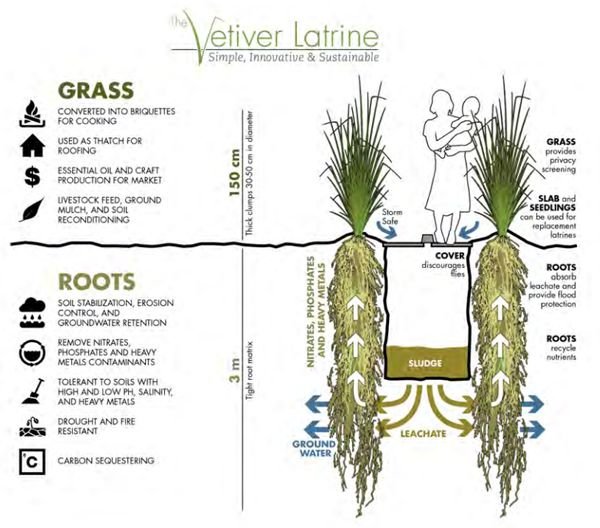
Saba bananas
These bananas are the local type, Punti' Saba because they withstand long periods of drought, are disease resistant, and they taste great either fresh or cooked as a plantain. They are a very large Banana growing 6 to 9 metres tall. Being in the wastewater garden we expect these will grow to their full height and potential as they recieved ideal supply of nutrients and water all year round. In Indonesian these Banans are called Pisang Kepok.
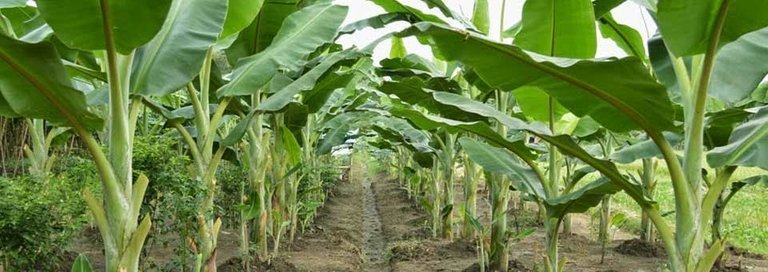

Elephant grass
This Grass is extremely fast growing and a good source of feed for animals. If cut frequently its also a good mulch, and the old canes can be used as stick fuel in rocket stoves for cooking
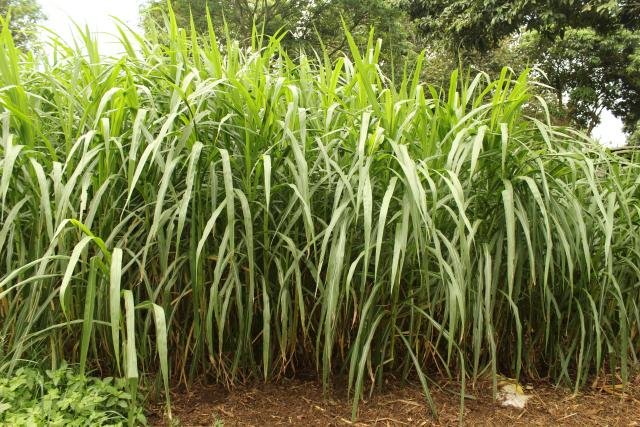
 http://www.feedipedia.org/node/395
http://www.feedipedia.org/node/395
Bana grass and Hybrid Napier
These are types of elephant grass that have been hybridized with Pearl millet and other grasses. They are the darlings of the tropical biomass industry as well as excellent animal feed.
The east African small holder dairy industry relies on this grass for their cut and carry model. In Lombok we don’t do any dairy but there are goats and sheep and these too can be raised based on a diet of these grasses, with some tree legumes for added protein
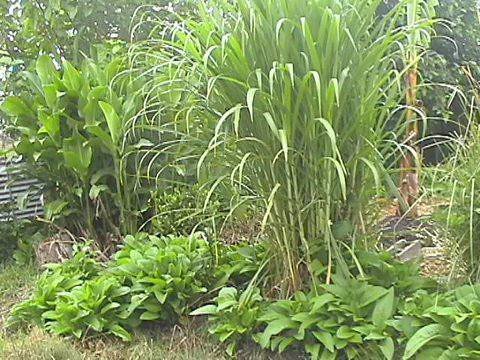
Canna
Canna indica is a common worldwide garden plat, its also a great waste water garden plant. The flowers are pretty, the Mulch is excellent and they can also be fed to cows and goats
 https://longwoodgardens.org/blog/2010/08/24/canna-we-save-the-canna
https://longwoodgardens.org/blog/2010/08/24/canna-we-save-the-canna
Comfrey
Comfrey can’t grow here. Its just too hot. But in temperate, highland tropical and subtropical regions it’s one of the very best ways to reclaim nutrients in the form of mulch. Bocking-14 is the best fodder ( and mulch type), and the leaves are equivalent or better than using cow manure in your vegetable garden. Apply liberally
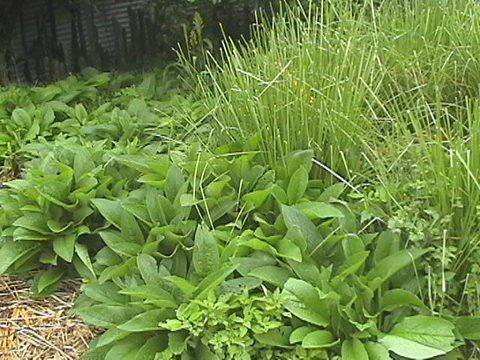
Please check out this steemit article by @balkep. It’s the best Comfrey article ever written IMHO
https://steemit.com/comfrey/@balkep/comfrey-believe-the-hype
Safe, above ground products for Greywater gardens
Grey water is pretty clean, so long as it isn’t stored more than 24 hours, probably more like 8 hours here in the hot tropics. If it's disposed of to mulched trenches then the microbes there eat all the pathogens and soak up the nutrients
Even so we apply the precautionary principle and stick to plants that can give produce above the soil level. This means no root crops and leafy greens
Think – trellis crops, shrubs and tree crops
Heavy mulching
We will mulch heavily, using mulch grown in the system as well as the excess from outside. To kick-start it we will buy some local corn cobs, rice hulls and coconut husks
These are some plants we can try out
Sugar cane
We will try some sugar cane. Rather than for consumption my interest is for later when we have livestock and a biogas unit, feeding stocks like sugar cane and cassava peelings to the biogas is much more productive than manures.
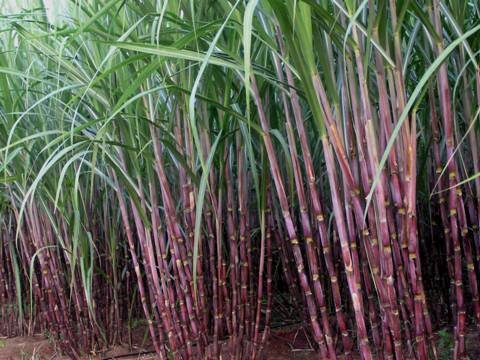
Papaya
Papaya suits wastewater gardens very well

Dry pole beans
Just for extra safety we will grow dry beans instead of green beans. Lima beans, Lablab bean, Pigeon pea are all suitable as tall or climbing types that will be far above the ground. The ground wuill be heavily mulched with Vetiver grass for weed control and dust suppression.
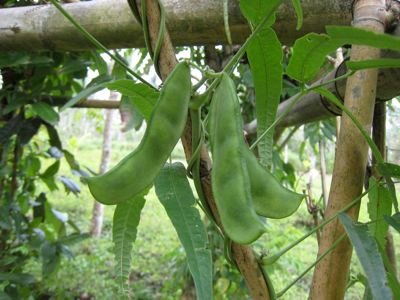
Bitter melon
Called Pare in indonesian and Priye in Sasak. This is a bitter but very healthy and popular vegetable in Sasak cuisine. It has numerous health benefits including antidiabetic and immune stimulation.

Sticky Corn - Jagung Ketan
This comes in White, black or mixed tones. Its starch is sticky like sticky rice. These are boiled then grilled. These a re a popular snack in Lombok and Sumbawa
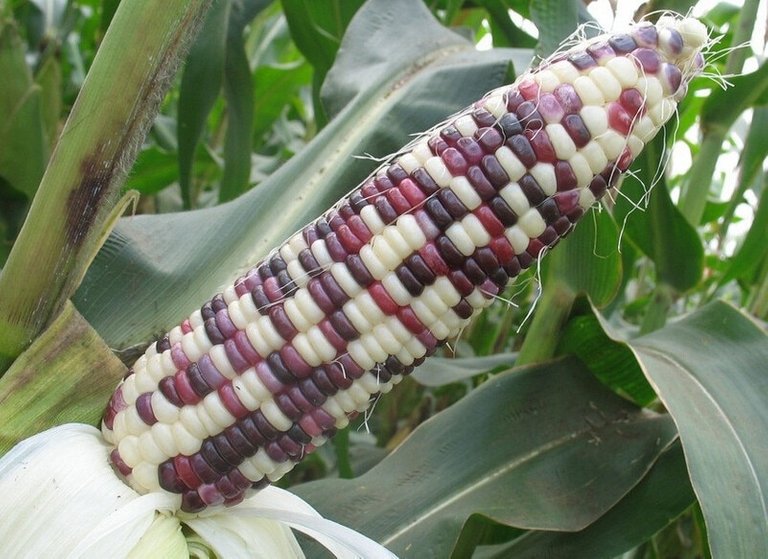
Next..
We install the roof, the SS diverter and begin building the vermifiltration tanks. We will also discuss how we prepare our planting materials cheaply and efficiently
This project is fully funded by

This build is funded by Ecoregions Indonesia, as part of their ongoing support for the people of Sekaroh forest, with a 9 million Indonesian rupiah research and build budget, along with the use of Ecoregions staff hours to make and test the prototype. After some months testing, we hope to also gather some Steem community support to continue prototype and business model development for job creation.
We hope you follow our progress towards a workable solution to these problems that is socially acceptable, economically sound and environmentally beneficial.

please Comment, Upvote, Share or Resteem!

Full vote and follow for you here. Awesome stuff and information, thank you.
look forward to some more learning about permacultures